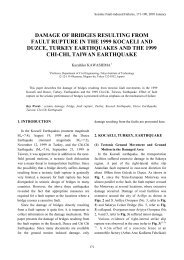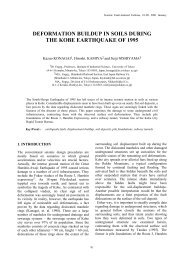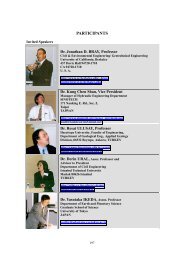simple expression of the dynamic stiffness of grouped piles
simple expression of the dynamic stiffness of grouped piles
simple expression of the dynamic stiffness of grouped piles
You also want an ePaper? Increase the reach of your titles
YUMPU automatically turns print PDFs into web optimized ePapers that Google loves.
14 SIMPLE EXPRESSIONS OF THE DYNAMIC STIFFNESS OF GROUPED PILESmass, damping and <strong>stiffness</strong> parameters; <strong>the</strong> parameters are invariant <strong>of</strong> frequency andare dependent only on <strong>the</strong> mechanical properties <strong>of</strong> soil and pile. The method presentedin this report requires real-time manipulation <strong>of</strong> soil-structure interaction parameters inaccordance with <strong>the</strong> development <strong>of</strong> non-linear features <strong>of</strong> soils and <strong>piles</strong>. The present<strong>simple</strong> <strong>expression</strong> <strong>of</strong> pile-cap <strong>stiffness</strong>, thus proves to be useful despite <strong>the</strong> availability<strong>of</strong> efficient numerical programs for analyzing pile-soil-pile interaction.2.2 EQUIVALENT SINGLE UPRIGHT BEAMIn discussing <strong>the</strong> equivalent upright beam, straightforward evaluation <strong>of</strong> pile-soil-pileinteraction is first necessary to provide rigorous solutions. Based on <strong>the</strong> numericalscheme presented by Tajimi and Shimomura [Thin-Layered Method, 1976] that allowssoil-embedded foundation interaction effects to be rigorously evaluated, a numericalprogram “TLEM”(Ver. 1.1) has been developed for soil-pile group interaction analyses[Konagai, 1998d]. The Thin-Layered Element Method is a method for describing soilstrata ra<strong>the</strong>r than for foundations. In this method, a soil deposit is treated as an infinitestratified medium with <strong>the</strong> inclusion <strong>of</strong> a cylindrical hollow in which <strong>the</strong> foundation isfitted. The <strong>piles</strong> are assumed to be upright Timoshenko or Beronoulli-Euler beams. Theevaluation <strong>of</strong> pile-soil-pile interaction effects in this program is based on <strong>the</strong>superposition method that was originally proposed by Poulos [1968, 1971]. In thisapproximation, only two <strong>piles</strong> are considered in <strong>the</strong> formulation <strong>of</strong> a global flexibilitymatrix, and o<strong>the</strong>r <strong>piles</strong>’ effects on <strong>the</strong>se two <strong>piles</strong> are totally ignored (Figure 2.1).Kanya and Kausel [1982] have shown that <strong>the</strong> superposition scheme gives reasonableresults not only for static loads but for <strong>dynamic</strong> loads as well.active pilexθs d = 2r 0passive pileyFigure 2.1 Active and passive <strong>piles</strong>






